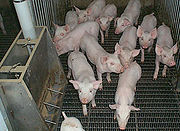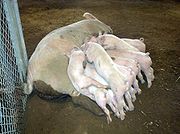
Pig farming
Encyclopedia


- Money or capital available
- The type of animals kept
- Local requirements and market conditions
- The level of management skills
Pigs can be farmed in free range
Free range
thumb|250px|Free-range chickens being fed outdoors.Free range is a term which outside of the United States denotes a method of farming husbandry where the animals are allowed to roam freely instead of being contained in any manner. In the United States, USDA regulations apply only to poultry and...
, being allowed to wander around a village, kept in fields, or tethered in a simple house. In developed countries, farming has moved away from traditional pig farming
Sty
A sty or pigsty is a small-scale outdoor enclosure for raising domestic pigs. It is sometimes referred to as a hog pen, hog parlor, pigpen, pig parlor, or pig-cote. Pigsties are generally fenced areas of bare dirt and/or mud. Both "sty" and "pigpen" are used as derogatory descriptions of dirty,...
and pigs are now typically intensively farmed
Intensive pig farming
Intensive piggeries are a type of factory farm ' specialized in the raising of domestic pigs up to slaughter weight...
. Today, hog operations are significantly larger than in the past, with most large-scale farms housing 5,000 or more pigs in climate-controlled buildings. With 100 million hogs slaughtered each year, these efficiencies deliver affordable meat for consumers and larger profits for producers.
Individual farm management focuses on housing facilities, feeding and ventilation systems, temperature and environmental controls and the economic viability of their operations. Just as producers have to determine profit margins and types of facilities and equipment for their farm, they must also find the practices that best fit their specific situation. Some procedures and treatments are known to stress the animals and producers should consider the animals' welfare, health and management in correspondence with accepted husbandry skills.
Use as food
Almost all of the pig can be used as food. Preparations of pig parts into specialties include; sausageSausage
A sausage is a food usually made from ground meat , mixed with salt, herbs, and other spices, although vegetarian sausages are available. The word sausage is derived from Old French saussiche, from the Latin word salsus, meaning salted.Typically, a sausage is formed in a casing traditionally made...
, bacon
Bacon
Bacon is a cured meat prepared from a pig. It is first cured using large quantities of salt, either in a brine or in a dry packing; the result is fresh bacon . Fresh bacon may then be further dried for weeks or months in cold air, boiled, or smoked. Fresh and dried bacon must be cooked before eating...
, gammon, ham
Ham
Ham is a cut of meat from the thigh of the hind leg of certain animals, especiallypigs. Nearly all hams sold today are fully cooked or cured.-Etymology:...
, skin into pork scratchings, feet into trotters, head into a meat jelly called head cheese
Head cheese
Head cheese , or brawn , is a cold cut that originated in Europe. A version pickled with vinegar is known as souse. Head cheese is not a cheese but a terrine or meat jelly made with flesh from the head of a calf or pig , and often set in aspic. Which parts of the head are used can vary, but the...
(brawn) and consumption of the Liver
Liver
The liver is a vital organ present in vertebrates and some other animals. It has a wide range of functions, including detoxification, protein synthesis, and production of biochemicals necessary for digestion...
, chitterlings
Chitterlings
Chitterlings are the intestines of a pig, although cattle and other animals' intestines are similarly used, that have been prepared as food. In various countries across the world, such food is prepared and eaten either as part of a daily diet, or at special events, holidays or religious...
, blood
Blood
Blood is a specialized bodily fluid in animals that delivers necessary substances such as nutrients and oxygen to the cells and transports metabolic waste products away from those same cells....
(blood pudding or black pudding) are common.
Pig farming terminology
Pigs have been extensively farmed, and therefore the terminology is well developed.- Pig, hog or swine, the species as a whole, or any member of it. The singular of "swine" is the same as the plural.
- Shoat, piglet or (where the species is called "hog") pig, unweaned young pig, or any immature pig.
- Sucker, a pig between birth and weaning.
- RuntRuntA runt is a smaller specimen in a group of animals, usually of offspring in a litter.Runt may also refer to:*Runt , a 1970 album by Todd Rundgren, originally credited to the band Runt...
, an unusually small and weak piglet, often one in a litter. - Boar or hog, male pig of breeding age.
- Barrow, male pig castratedCastrationCastration is any action, surgical, chemical, or otherwise, by which a male loses the functions of the testicles or a female loses the functions of the ovaries.-Humans:...
before puberty. - Stag, male pig castrated later in life, (that is, an older boar after castration).
- Gilt, young female not yet mated, or not yet farrowed, or after only one litter (depending on local usage).
- Sow, breeding female, or female after first or second litter.
Pigs for slaughter
- Suckling pigSuckling pigA suckling pig is a piglet fed on its mother's milk . In culinary, a suckling pig is slaughtered between the ages of two and six weeks. It is traditionally cooked whole, often roasted, in various cuisines...
, a piglet slaughtered for its tender meat. - Feeder pig, a weaned gilt or barrow weighing between 18 kg (39.7 lb) and 37 kg (81.6 lb) at 6 to 8 weeks of age that is sold to be finished for slaughter.
- Porker, market pig between 30 kg (66.1 lb) and about 54 kg (119 lb) dressed weight.
- Baconer, a market pig between 65 kg (143.3 lb) and 80 kg (176.4 lb) dressed weight. The maximum weight can vary between processors.
- Grower, a pig between weaning and sale or transfer to the breeding herd, sold for slaughter or killed for rations.
- Finisher, a grower pig over 70 kg (154.3 lb) liveweight.
- Butcher hog, a pig of approximately 100 kg (220.5 lb), ready for the market.
- Backfatter, cull breeding pig sold for meat; usually refers specifically to a cull sow, but is sometimes used in reference to boars.
Groups
- Herd, a group of pigs, or all the pigs on a farm or in a region.
- Sounder, a small group of pigs (or wild boar) foraging in woodland
Pig parts
- Trotters, the feet of pigs (they have four hoofHoofA hoof , plural hooves or hoofs , is the tip of a toe of an ungulate mammal, strengthened by a thick horny covering. The hoof consists of a hard or rubbery sole, and a hard wall formed by a thick nail rolled around the tip of the toe. The weight of the animal is normally borne by both the sole...
ed toes, walking mainly on the larger central two).
Biology
- In pig, pregnant.
- Farrowing, giving birth.
- Hogging, a sow when on heat (during estrus).
Housing
- StyStyA sty or pigsty is a small-scale outdoor enclosure for raising domestic pigs. It is sometimes referred to as a hog pen, hog parlor, pigpen, pig parlor, or pig-cote. Pigsties are generally fenced areas of bare dirt and/or mud. Both "sty" and "pigpen" are used as derogatory descriptions of dirty,...
, a small pig-house, usually with an outdoor run or a pig confinement. - Pig-shed, a larger pig-house.
- Ark, a low semi circular field-shelter for pigs
- Curtain-barn, a long, open building with curtains on the long sides of the barn. This increases ventilation on hot, humid summer days.
See also
- Pig slaughterPig slaughterPig slaughter is the work of slaughtering domestic pigs which is both a common economic activity as well as a traditional feast in some European countries.-Agriculture:...
- List of pig breeds
- ECODIPTERAECODIPTERAECODIPTERA project, co-financed by the European program LIFE , aims at showing an innovative method of treating pig manure...
- Exotic petExotic petAn exotic pet is a rare or unusual animal pet, or an animal kept as a pet which is not commonly thought of as a pet.The definition is an evolving one; some rodents, reptiles, and amphibians have become firmly enough established in the world of animal fancy to no longer be considered exotic...
- Extensive farmingExtensive farmingExtensive farming or Extensive agriculture is an agricultural production system that uses small inputs of labour, fertilizers, and capital, relative to the land area being farmed....
- Factory farmingFactory farmingFactory farming is a term referring to the process of raising livestock in confinement at high stocking density, where a farm operates as a factory — a practice typical in industrial farming by agribusinesses. The main products of this industry are meat, milk and eggs for human consumption...
- Intensive farmingIntensive farmingIntensive farming or intensive agriculture is an agricultural production system characterized by the high inputs of capital, labour, or heavy usage of technologies such as pesticides and chemical fertilizers relative to land area....
- Intensive pig farmingIntensive pig farmingIntensive piggeries are a type of factory farm ' specialized in the raising of domestic pigs up to slaughter weight...
- Miniature pigMiniature pigA miniature pig is one of the breeds developed and used for medical research or developed for use as a pet. These smaller pigs were first used for medical research in Europe before being introduced to the United States as pets in the 1980s. Since then, the animals have been used in studies by...
- Taboo meat
- Iron Age pigIron Age PigThe Iron Age pig is a hybrid between a wild boar and a domestic pig meant to recreate the type of pig represented by prehistoric art works of the Iron Age. The project started in the early 1980s by crossing a male wild boar with a Tamworth sow to produce an animal that looks like the pig from long...

